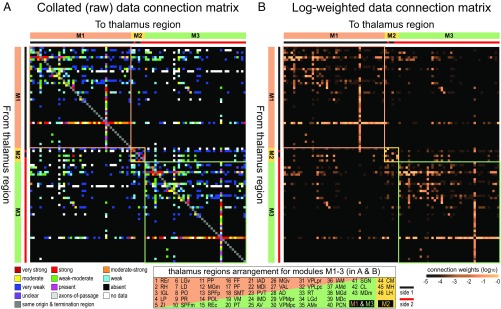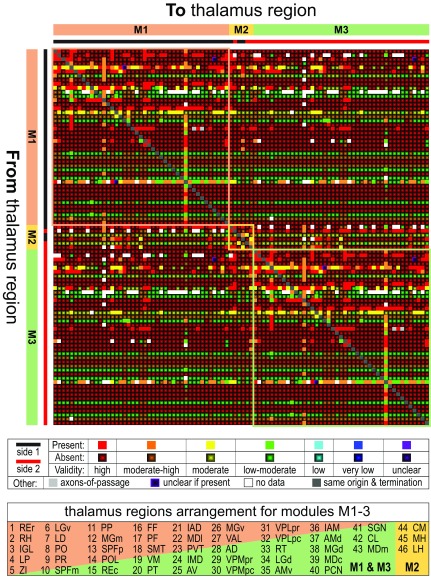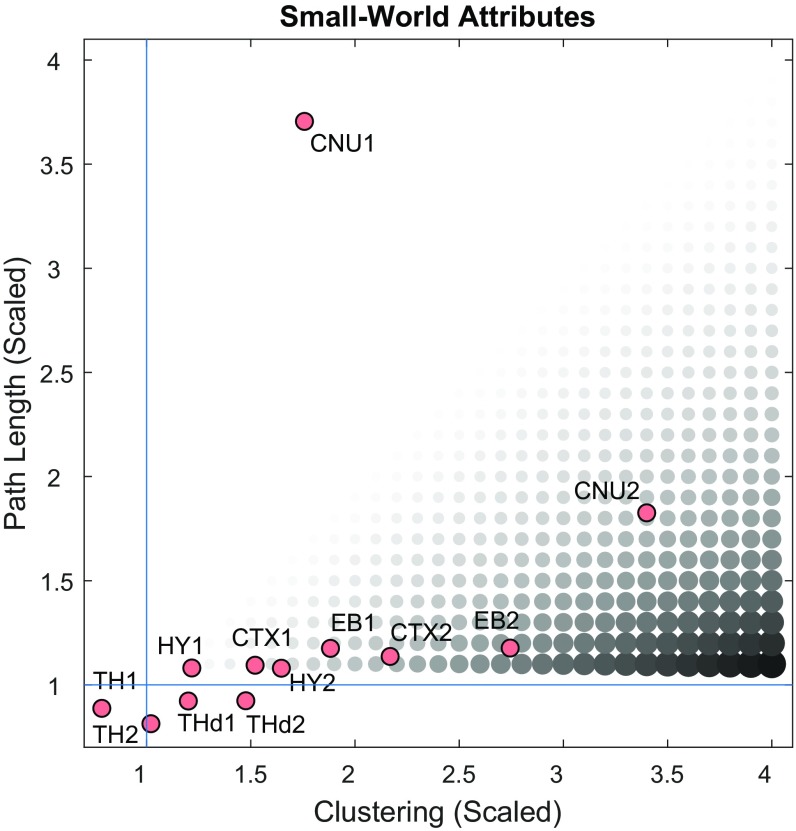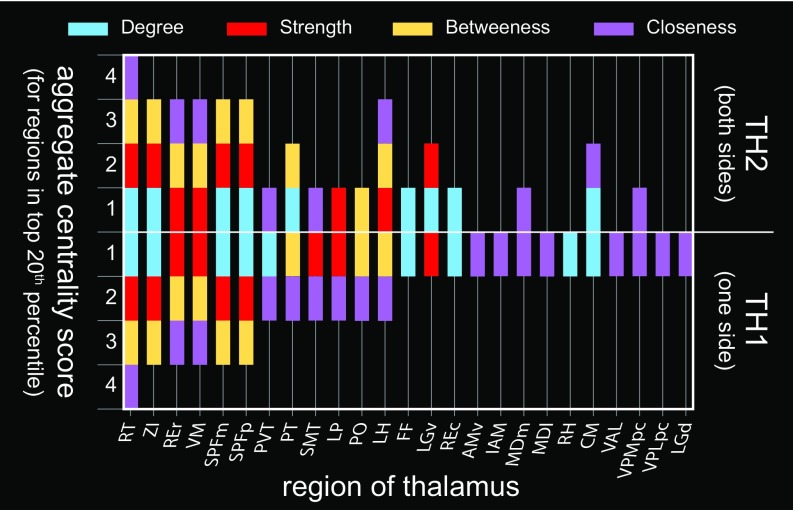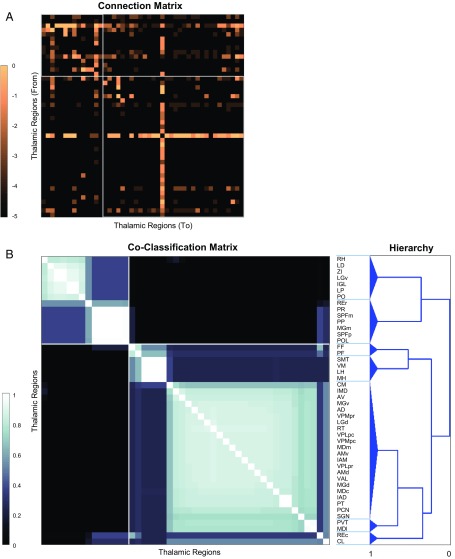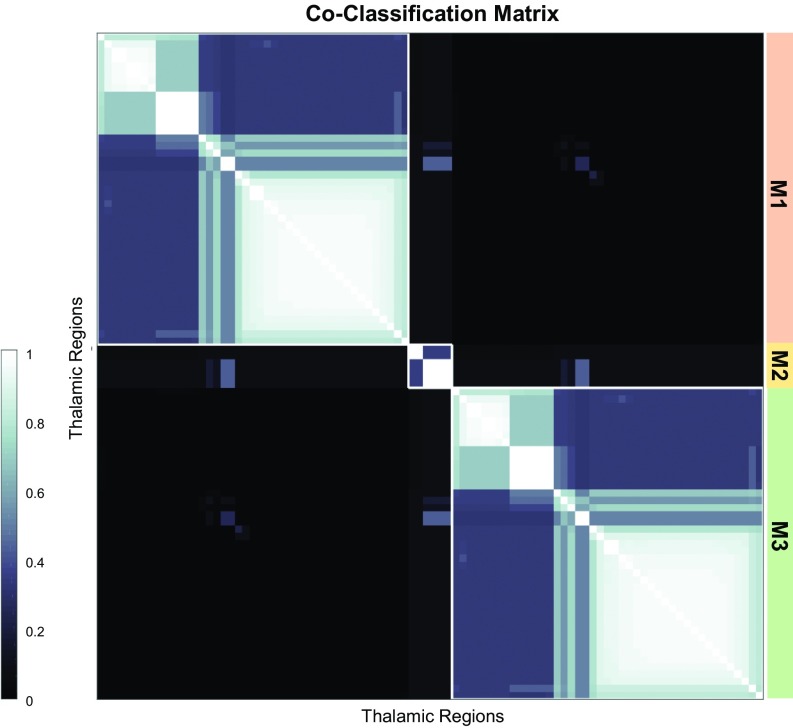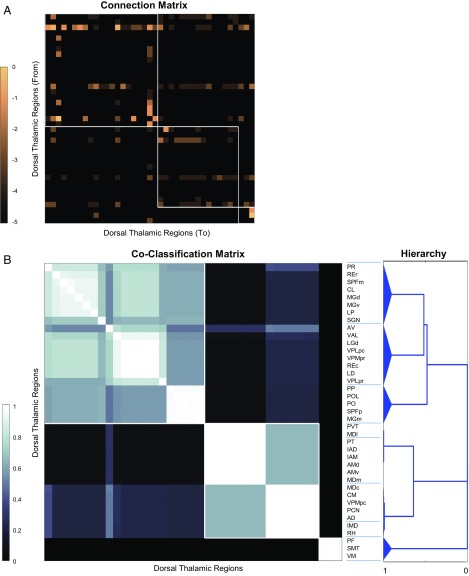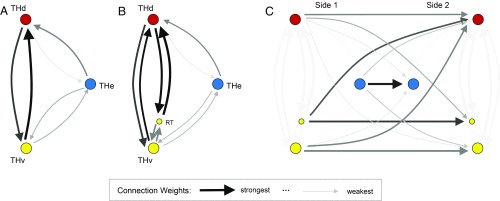Significance
The thalamus is 1 of 4 major divisions of the forebrain, and one key function is to act as a “relay” for specific types of information to reach the cerebral cortex in an ordered way. A matrix of axonal connections among the 46 rat thalamic nuclei on each side of the brain was derived from collated data and used to clarify the organization of this intrinsic thalamic circuitry with network analysis tools. Compared with the other 3 forebrain divisions, the intrathalamic network is sparsely connected, and only one region, the reticular thalamic nucleus, is a hub. Direct comparisons using the same network analysis tools indicate that each division of the forebrain has a distinct set of intrinsic network organizational features.
Keywords: connectomics, mammal, neural connections, neuroinformatics, subsystems
Abstract
The thalamus is 1 of 4 major divisions of the forebrain and is usually subdivided into epithalamus, dorsal thalamus, and ventral thalamus. The 39 gray matter regions comprising the large dorsal thalamus project topographically to the cerebral cortex, whereas the much smaller epithalamus (2 regions) and ventral thalamus (5 regions) characteristically project subcortically. Before analyzing extrinsic inputs and outputs of the thalamus, here, the intrinsic connections among all 46 gray matter regions of the rat thalamus on each side of the brain were expertly collated and subjected to network analysis. Experimental axonal pathway-tracing evidence was found in the neuroanatomical literature for the presence or absence of 99% of 2,070 possible ipsilateral connections and 97% of 2,116 possible contralateral connections; the connection density of ipsilateral connections was 17%, and that of contralateral connections 5%. One hub, the reticular thalamic nucleus (of the ventral thalamus), was found in this network, whereas no high-degree rich club or clear small-world features were detected. The reticular thalamic nucleus was found to be primarily responsible for conferring the property of complete connectedness to the intrathalamic network in the sense that there is, at least, one path of finite length between any 2 regions or nodes in the network. Direct comparison with previous investigations using the same methodology shows that each division of the forebrain (cerebral cortex, cerebral nuclei, thalamus, hypothalamus) has distinct intrinsic network topological organization. A future goal is to analyze the network organization of connections within and among these 4 divisions of the forebrain.
Classically, the forebrain has 4 divisions, the cerebral cortex and cerebral nuclei (together the endbrain), and the thalamus and hypothalamus—together the interbrain (1, 2). For the systematic creation of a top-level network analysis of the mammalian brain’s wiring diagram, we began rostrally with the intrinsic bilateral connectivity of the cerebral cortex (3), the cerebral nuclei (4), and the hypothalamus (5). The results of this type of analysis provide insight into how the network of association (ipsilateral) and commissural (contralateral) connections for a particular nervous system division are organized when considered in isolation; that is, without accounting for axonal inputs from, and outputs to, other parts of the nervous system. This study provides a similar analysis for the thalamus and the opportunity to compare its intrinsic circuitry with that described for each of the other 3 major divisions of the forebrain.
The thalamus is considered classically to have 3 major subdivisions based on developmental, topographic, and extrinsic connectional patterns: epithalamus (THe), dorsal thalamus (THd), and ventral thalamus (THv) (6). The THd is by far the largest of these subdivisions in terms of its gray matter volume and the number of its gray matter regions (39 out of 46 for the complete thalamus on each side of the brain), and it is regarded as the “gateway” to the cerebral cortex with each gray matter region (or nucleus or node) projecting to a specific cortical region or set of cortical regions (6). In contrast, the THe (habenular nuclei) and THv (reticular and ventral lateral geniculate nuclei, intergeniculate leaflet, zona incerta, and fields of Forel) are much smaller and have virtually no projections to the cerebral cortex (6).
For the purposes of this analysis, axonal connections among all 46 thalamic nuclei recognized on one side of the rat brain in a standard atlas (7) have been considered (whether THe, THd, or THv) along with the connections established by these nuclei with the 46 corresponding thalamic nuclei on the other side of the brain. Monosynaptic connection reports using axonal pathway-tracing methods were collated from the structural neuroscience literature at the macroscale (“from gray matter region A to gray matter region B”) level (8, 9), the only granularity level globally represented thus far in the adult vertebrate literature. The resulting connection matrix was subjected to formal network analysis. Collation was restricted to data from the rat where, by far, the most published connection data exist, and all such data were converted, if necessary, to the only available nomenclature scheme that is formally defined, complete, internally consistent, and hierarchically organized (7).
The goals of this research are to create a gold-standard online database of intrathalamic connections, to provide a top-level conceptual model for understanding intrathalamic circuitry at finer levels of granularity (neuron types within a region, individual neurons within a neuron type, and synapses associated with individual neurons) (10), and to compare the organization of intrathalamic circuitry with the intrinsic circuitry of other major forebrain divisions. Future goals are to analyze the organization of connections among these divisions of the forebrain, and then their connections with the rest of the nervous system.
Results
There are 2,070 (462−46) possible ipsilateral (uncrossed, association) macroconnections among the 46 gray matter regions of the rat thalamus on one side of the brain (a connection from a region to itself is not considered) and 2,116 (462) possible contralateral (crossed, commissural) macroconnections from those 46 regions to the corresponding regions of the thalamus on the other side of the brain. Thus, the thalamus on one side has 4,186 possible ipsilateral and contralateral connections, and the right and left thalami together have 8,372 possible connections. Our systematic review of the primary structural neuroscience literature identified no reports of statistically significant male/female, right/left, or strain differences for any ipsilateral or contralateral intrathalamic connections used for the analysis, which thus applies simply to the species level (adult rat).
A dataset of 8,795 connection reports for ipsilateral and contralateral connections from one thalamus was expertly collated by L.W.S. from 108 original research publications published since 1977 for the 4,186 possible connections (given no reports of statistically significant right/left differences, these numbers are doubled to give 17,590 connection reports for 8,372 possible connections arising from both sides of the brain). The connection reports were from 24 journals (49.0% from the Journal of Comparative Neurology and 15.4% from Brain Research) involving about 68 laboratories. In total, 15 different methods were used in generating the connection reports; the pathway-tracing method and other metadata associated with each report are identified in Dataset S1.
Basic Connection Numbers.
The collation identified 347 ipsilateral intrathalamic connections as present and 1,703 as absent for a connection density of 16.9% (347/2,050). In contrast, 112 contralateral connections from one thalamus to the other were identified as present, and 1,937 were identified as absent for a connection density of 5.5% (112/2,049). No published data were found for 20 (1.0%) of all 2,070 possible ipsilateral connections for a matrix coverage (fill ratio) of 99.0% (Fig. 1A), whereas matrix coverage for contralateral connections from one thalamus to the other was 96.8% (no article found for 67, 3.2%, of all 2,116 possible connections). Assuming the connection reports collected from the literature representatively sample the 46-region matrix for each side of the brain, the complete association connection dataset for one thalamus would contain ∼350 macroconnections (2,070 × 0.169), and the complete contralateral connection dataset would contain ∼116 macroconnections (2,116 × 0.055).
Fig. 1.
Bilateral rat intrathalamic macroconnectome (TH2). (A and B) Directed and weighted monosynaptic macroconnection matrices with gray matter region sequence in a subsystem (modular) arrangement derived from multiresolution consensus clustering (MRCC) analysis (Fig. 6). Connection weights are represented by descriptive values (A) and on a log10 scale derived from the descriptive values (B), and both measures are represented for identical datasets for each side of the thalamus. Sides 1 and 2 (left or right) are indicated by the thick red/black lines just to the left and on top of each matrix. 3 top-level subsystems (modules M1–3) are delineated: M1 and M3 involve unilateral connections (within side 1 or side 2), and M2 involves bilateral connections (within and between sides). The obvious crosses formed by a single row and column in M1 and M3 represent connections of the reticular thalamic nucleus. Region abbreviations are defined in Dataset S2.
Based on the available data (with reported values of “unclear” binned with “absent”), connection densities for ipsilateral and contralateral intrathalamic macroconnections were as follows: ipsilateral = 16.9% (347/2,050), contralateral = 5.5% (112/2,049), and ipsilateral and contralateral together = 11.2% (459/4,099). The range of ipsilateral output connections (degrees) per thalamic region is 1–38, and the range for ipsilateral plus contralateral output connections is 1–56. Conversely, the range of ipsilateral input connections per thalamic region is 1–36, and the range for ipsilateral plus contralateral input connections is 1–42. The range for total (input plus output) connections per region within and between the right and the left thalamus is 3–94.
Although the range of in-degree and out-degree for all regions (nodes) in a network provides a general overview of connectivity, to identify those regions that provide the most substantial contribution to the network, it is necessary to examine the connections of individual regions. This point is illustrated here by reticular thalamic nucleus connections, which account for 60.3% of all unilateral intrathalamic connections aggregated by weight (Fig. 1). The summed weight of all weighted connections is 31.5, and removing the reticular thalamic nucleus reduces this value to 12.5. Compared with the other 3 forebrain divisions, the intrathalamic macroconnections are sparse (see Discussion).
We also applied a metric for the validity of pathway-tracing methods for the collated connection reports (3, 11). The average validity of the pathway-tracing methods for macroconnection reports of present intrathalamic macroconnections selected for network analysis was 6.21 (on a scale of 1 = lowest to 7 = highest); it was 6.23 for selected reports of macroconnections that do not exist (absent) (Fig. 2 and Dataset S1). For weighted network analysis, an exponential scale was applied as in our previous studies (3–5, 11) to the ordinal weight categories (Fig. 1B).
Fig. 2.
Comparative matrix of intrathalamic macroconnections and validity of pathway-tracing methods. The matrix combines a weighted and directed macroconnection matrix for the bilateral intrathalamic subconnectome (Fig. 1) with a measure of the validity of the experimental pathway-tracing methods for present or absent connections, based on a 7-point scale (see ref. 3 for an extended description of the approach). Note that, for connections reported as absent, a lower pathway-tracing method validity does not necessarily reduce the validity of the data (see the methodological discussion in ref. 3). Region arrangement and top-level subsystems (delineated modules M1–3) are derived from multiresolution consensus clustering analysis (Figs. 1 and 6). Region abbreviations are defined in Dataset S2.
Network Attributes.
We analyzed the intrathalamic macroscale subconnectome for several network attributes as in our previous studies (3–5, 11). These included the attributes of small-world (applied to networks with highly clustered nodes connected via short paths) and “rich club” (applied to networks with a group of well-connected and densely interconnected nodes). We also investigated network centrality (indicative of the relative “importance” of network nodes) using 4 centrality measures: degree, strength, betweenness, and closeness. Degree is a measure of the number of input or output connections (described as the in- or out-degree) for each network node (i.e., here, each gray matter region); strength represents the total weight of each node’s macroconnections; betweenness and closeness take account of the shortest paths between nodes and provide an indication of node centrality with respect to putative information flow.
Investigation of these network attributes for the rat intrathalamic macroconnectome revealed a simple basic connection topology (network arrangement). The unilateral thalamus (TH1) and the bilateral thalamus (TH2) intrathalamic networks do not show small-world attributes (Fig. 3). Network centrality analysis for degree, strength, betweenness, and closeness indicated the TH1 network has only one hub (highly interconnected and highly central node) (Fig. 4), the reticular thalamic nucleus, and the TH2 network has only 2 hubs, the reticular thalamic nucleus on each side of the brain (Fig. 4).
Fig. 3.
Comparison of small-world analysis for the thalamus and other forebrain divisions. Small-world networks have 2 properties: highly clustered nodes (densely interconnected) and short paths connecting the nodes. Clustering is computed as the nodal mean of the weighted and directed clustering coefficients, whereas path length is computed as the global mean of the weighted path lengths between all node pairs. Both metrics are scaled by the median of the corresponding measures obtained from 1,000 degree-preserving randomized networks. The diameter and gray level value of circles correspond to the ratio between scaled clustering and scaled path length, the small-world index (23). For a network to display small-world attributes, this index should be >1 with a high (scaling ≫1) clustering index and a short (scaling near 1) path length. Neither the TH1 and dorsal thalamus (THd1) nor the TH2 and dorsal thalamus (THd2) show small-world features. Disconnection of the THd1/THd2 networks required the use of medians for computing small-world metrics. For comparison, values are also plotted for previously reported subconnectomes for the endbrain (EB1 and EB2) (11), its component parts, the cerebral cortex (CTX1 and CTX2) (3), and cerebral nuclei (CNU1 and CNU2) (4).
Fig. 4.
Central nodes of the thalamic network. Identification of candidate hub regions and others with high network centrality for the TH2 and TH1 thalamic subconnectomes. Regions are assigned a score of 0–4 according to the number of times they fall within the top 20th percentile for each of 4 measures of centrality (degree, strength, betweenness, and closeness) and are arranged from left to right by TH1 descending aggregate centrality and then topographically (7). Regions with a centrality score of 4 are considered candidate hubs. Note that aggregate centrality scores are modulated between TH1 and TH2, indicative of the relevance of TH2 contralateral connections to the overall structure of the network. Region abbreviations are defined in Dataset S2.
Modularity/Subsystem Organization.
MRCC analysis (12) applied to the unilateral 46 × 46 thalamic connection matrix (TH1; for the right or the left side of the brain) yielded a very simple top-level or first-order solution with just 2 subsystems (Fig. 5A) and a bottom-level solution with 7 subsystems, 2 in the smaller top-level subsystem, and 5 in the larger top-level subsystem (Fig. 5B). The hierarchy or cluster tree for this subsystem or module analysis based on a complete coclassification matrix has 6 levels or solutions (Fig. 5B). The clustering of regions in this hierarchy (Fig. 5B) is not readily interpretable in terms of classical ways the thalamus has been parceled, that is, topographically, developmentally, or with respect to extrinsic input/output patterns (6, 7, 13), perhaps because the network is so sparsely connected.
Fig. 5.
Connection and coclassification network matrices for the unilateral intrathalamic (TH1) subconnectome. (A) Directed and weighted monosynaptic macroconnection matrix for the rat thalamus on one side (TH1) with the gray matter region sequence in a modular or subsystem arrangement derived from MRCC analysis (shown in B). Connection weights are represented on a log10 scale (Left). 2 top-level modules are outlined in white. (B) Complete coclassification matrix obtained from MRCC analysis (as in A) for the 46 regions of the thalamus on one side. A linearly scaled coclassification index (Left) gives a range between 0 (no coclassification at any resolution) and 1 (perfect coclassification across all resolutions). Ordering and hierarchical arrangement (Right) are determined after building a hierarchy of nested solutions (100,000 event samples) that recursively partition each cluster/subsystem, starting with the 2 top-level clusters/subsystems (M1 Upper Left and M2 Lower Right). The 7 subsystems obtained for the finest partition are indicated on the left edge of the dendrogram, whereas the 2 top-level subsystems (corresponding to M1 and M2) appear at the root of the tree (far right edge). A total of 6 distinct hierarchical levels are present as determined by the number of vertical cuts through each unique set of branches. The length of each distinct set of branches represents a distance between adjacent solutions in the hierarchical tree that may be interpreted as its persistence along the entire spectrum; dominant solutions extend longer branches, whereas fleeting or unstable solutions extend shorter branches. All solutions plotted in the tree survive the statistical significance level of α = 0.05. Region abbreviations are defined in Dataset S2.
MRCC analysis applied to the entire 92 × 92 bilateral connection matrix between the right and the left thalamus (TH2) also yielded a simple top-level solution of just 3 subsystems (Figs. 1 and 6). 2 of the subsystems are large and have identical components with one subsystem in the right thalamus and the other subsystem in the left thalamus. The third subsystem (in the middle of the plots in Figs. 1 and 6) consists of 3 pairs of right/left-sided regions. The complete coclassification matrix has 12 bottom-level subsystems arranged in a hierarchy with 11 levels (SI Appendix, Fig. S1). As with the unilateral MRCC analysis, the clustering of regions in this bilateral hierarchy is not readily interpretable in terms of classical ways the thalamus has been parceled.
Fig. 6.
Complete coclassification matrix obtained from MRCC analysis (as in Fig. 5B) for the 92 regions of the thalamus on both sides of the brain (the same 46 regions on each side). 2 large top-level subsystems (modules) have identical components in each side of the thalamus, whereas the small (Middle) subsystem is bilateral. Subsystem composition and hierarchical tree are shown in SI Appendix, Fig. S1.
Dorsal Thalamus Network Attributes.
The number of regions (nodes) in the THe and in the THv (which contains the reticular thalamic nucleus) is too small for meaningful network analysis as applied here. However, the well-known THd on each side of the brain has 39 nodes, and this subset of the total connection matrix was subjected to the same network analysis as the entire thalamus for the sake of comparison.
A total of 148 ipsilateral intrathalamic THd connections were identified as present, and 1,320 were identified as absent for a connection density of 10.1% (148/1,468). In contrast, 28 contralateral connections between the THd on either side of the thalamus were identified as present, and 1,442 were identified as absent for a connection density of 2.0% (28/1,470). No published data were found for 14 (1.0%) of all 1,482 possible ipsilateral THd connections for a matrix coverage (fill ratio) of 99.0% (Fig. 1A), whereas matrix coverage for contralateral connections between each THd was 96.6% (no article found for 51 of 1,521 possible connections). Assuming the connection reports collated from the literature representatively sample the 39-region matrix for each side of the brain, the complete association connection dataset for the THd on one side would contain ∼150 macroconnections (1,482 × 0.101), and the complete contralateral THd connection dataset would contain ∼30 macroconnections (1,521 × 0.020).
The range of the number of ipsilateral output connections (degrees) per THd region is 1–23, and the range for ipsilateral plus contralateral output connections of the THd is 1–32. Conversely, the range of ipsilateral input connections per THd region is 1–14, and the range for ipsilateral plus contralateral input THd connections is 1–16. The range for total (input plus output) connections per region within and between the right and the left THd is 1–39.
The intrinsic macroconnectivity of the THd is very sparse. As one measure of this feature, 40.0% (593/1,482) of all pairwise paths among the 39 THd regions/nodes do not exist. In other words, 40% of all node pairs in the THd1 network are unable to link to or influence one another through THd1 connection paths of any length. In contrast, the entire thalamus is fully connected in the sense that any 2 of the 46 nodes in the network are linked by, at least, one possible path. That is, at least, one path of finite length exists between any 2 nodes/regions in the entire thalamus. This full connectivity of the entire thalamus is crucially dependent on the reticular thalamic nucleus (of the THv). Omitting the reticular thalamic nucleus from the network eliminates all paths between 30.5% (603/1,980) of all node pairs.
Commonly used global graph metrics for the THd1 and the THd2, such as the clustering coefficient (a measure of the degree to which a given node’s connected neighbors are also connected among each other) and path length, are displayed in Fig. 3 in direct comparison with previously reported measurements for other divisions of the forebrain. Not surprisingly, given the sparsity of the network, there is no indication of small-world organization in the THd1 network, and the same applies to the possible existence of rich club organization (as determined for the entire thalamus, above). On the other hand, based on the same criteria used for the entire thalamus, the THd1 network has 3 hubs: caudal nucleus reuniens, magnocellular subparafascicular nucleus, and parvicellular subparafascicular nucleus. The THd2 network has 6 hubs: the same 3 nuclei on each side of the brain.
Dorsal Thalamus Modularity/Subsystem Organization.
MRCC analysis applied to the unilateral 39 × 39 THd1 connection matrix yielded a very sparsely connected and simple top-level solution with just 3 subsystems (Fig. 7A) and a bottom-level solution with 6 subsystems (Fig. 7B). The hierarchy or cluster tree for this subsystem or module analysis has 6 levels or solutions. MRCC analysis applied to the entire 78 × 78 bilateral connection matrix between the right and the left THd (THd2) yielded a top-level solution of 5 subsystems (SI Appendix, Fig. S2); there is no simple way to summarize the contents and topographic distribution of these 5 subsystems within the right and left thalamus. The complete coclassification matrix has 15 bottom-level modules arranged in a hierarchy with 12 levels (SI Appendix, Fig. S2). As with the thalamus as a whole, the clustering of regions in the THd1 and THd2 hierarchies is not readily interpretable in terms of classical ways the dorsal thalamus has been parceled, again perhaps because the network is so sparsely connected.
Fig. 7.
Connection and coclassification network matrices for the THd1 subconnectome. (A) Directed and weighted monosynaptic macroconnection matrices for the rat dorsal thalamus on one side (THd1) with the 39 gray matter region sequence in a modular or subsystem arrangement derived from an MRCC analysis (shown in B) as described in Fig. 5B. Region abbreviations are defined in Dataset S2.
Connections Between Traditional Thalamic Subdivisions.
Examination of mean connection weight by thalamic subdivision (THe, THd, and THv; SI Appendix, Tables S1 and S2, and Fig. 8) shows that the only substantial ipsilateral connections are from THv to THd and that the only substantial crossed connections are from THe1 to THe2. It is also interesting to note that all 7 regions of the THe and THv have a known crossed connection to the same region on the opposite side of the brain (a homotopic connection), whereas only 5 of 39 THd regions have a known homotopic connection.
Fig. 8.
Schematic of averaged connection weights among anatomical subdivisions of the thalamus. Connection weights are displayed on an ordinal scale (stronger connections shown with thicker and darker arrows) according to their ranks in each panel. (A) Connections among the 3 thalamic subdivisions (THe, THv, and THd) on one side of the brain. (B) As A, but with the reticular thalamic nucleus (RT) visualized separately from the rest of its host subdivision, THv. (C) Both sides of the thalamus are shown with contralateral connections indicated from side 1 to side 2 only. For numerical comparison of connection weights see SI Appendix, Tables S1 and S2. THd, dorsal thalamus; THe, epithalamus; THv, ventral thalamus.
Discussion
As applied here, network analysis of the intrathalamic connection matrix suggests 2 main conclusions about organizing principles at the top macrolevel of granularity. First, systematic collation of the neuroanatomical literature in the rat confirmed the widely held view (6, 13) that, with one major exception, the various gray matter regions forming the thalamus are only sparsely interconnected by ipsilateral axonal connections and these regions are very sparsely interconnected by crossed connections to the contralateral thalamus. The second organizing principle requires more detailed consideration and involves the one exception—the reticular thalamic nucleus, a component of the THv forming a thin shell around the lateral border of the THd on each side of the brain.
The common view is that the reticular thalamic nucleus receives an ipsilateral input from most, if not all, dorsal thalamic nuclei and, in turn, projects back to most, if not all, of these nuclei (6, 13). The results collated here from published pathway-tracing experiments provide exact numbers for the rat. The reticular thalamic nucleus projects to, at least, 32 of the 39 dorsal thalamic nuclei (there is no available evidence for 5 of the 7 questionable connections, and there is evidence that the other 2 connections do not exist—to the peripeduncular and magnocellular subparafascicular nuclei), and 35 of the 39 dorsal thalamic nuclei have been shown to project to the reticular thalamic nucleus (there is no available evidence for one of the questionable connections, and there is evidence that the other 3 connections do not exist—from the lateral dorsal, parvicellular subparafascicular, and peripeduncular nuclei).
Importantly, the reticular thalamic nucleus alone accounts for about 60% of all ipsilateral intrathalamic connectivity (by total weight of connections), and due to its central position, the thalamus forms a fully connected network, that is, a path of finite length (comprising a greater or lesser number of connections) exists between every pair of (ipsilateral) thalamic regions—no thalamic region is isolated from the rest of the network at this macrolevel of analysis. Removal of the reticular thalamic nucleus (with 45 thalamic nodes remaining) results in a structurally fragmented network with about 30% of all node pairs becoming disconnected (no possible path within the network exists). The important role of the reticular thalamic nucleus is underscored by the observation that, in the 39-node THd1 network (lacking the reticular thalamic nucleus), 40% of all pairwise paths do not exist.
These results indicate that at the macrolevel of analysis the reticular thalamic nucleus, which is a feature common to all mammals (6), plays a critical role in assuring that the thalamus forms a fully connected network in the formal sense. The results also indicate that the network organization of the THd can only be fully appreciated by viewing its intrinsic circuitry in relation to extrinsic axonal inputs and outputs, a feature that is currently under investigation. It is also important to recognize that the axonal connections of the reticular thalamic nucleus are predominantly GABAergic whereas the axonal connections to the cerebral cortex of most, if not all, THd nuclei are glutamatergic (6, 13). These mixed physiological effects must be taken into account when interpreting the functional implications of the topologically central role of the reticular thalamic nucleus.
The basic network topology of intrinsic circuitry associated with the 4 major forebrain divisions (cerebral cortex, cerebral nuclei, thalamus, and hypothalamus) has now been characterized in one mammalian species with the same basic methodology (3–5, 11). The results indicate an unexpected diversity of network features among these 4 major divisions at the rostral end of the central nervous system (14–16). Contributing to this diversity are clear qualitative differences in small-world attributes of different brain divisions. Intrinsic cerebral cortical connectivity networks in mammals have been examined most extensively because of their functional significance in supporting cognitive mechanisms, and there is general agreement that the unilateral network (17–21) and the bilateral network (3) display clear small-world features. This is not the case, however, for the other 3 forebrain divisions where the 2 cardinal small-world features (high clustering combined with short path length) are only weakly expressed or entirely absent (Fig. 3).
Interestingly, the absence of clear small-world topology in 3 of the 4 forebrain divisions is not correlated with network connection density. For example, ipsilateral connection density for the intracerebral cortex network is 37% (network analysis value) with clear small-world features; whereas these features are marginal or absent for the ipsilateral intracerebral nuclei network also with a connection density of 37%, for the ipsilateral intrahypothalamic network with a connection density of 55%, and for the ipsilateral intrathalamic network with a connection density of 17%. Similarly, the presence of a high-degree rich club is also not correlated with network connection density. Both divisions of the endbrain exhibit rich club organization as indicated by the presence of dense connections among regions with high node degree. In stark contrast, neither part of the interbrain—the hypothalamus with 65 regions and the thalamus with 46 regions—displays any hint of rich club topology.
Putative hubs also display interesting features in the 4 intrinsic forebrain networks considered here. The ipsilateral, intracortical, and intracerebral nuclei networks, each with 37% connection density, have 7 and 5 hubs, respectively; whereas the ipsilateral intrahypothalamic network with 55% connectivity has 3 hubs, and the ipsilateral intrathalamic network with 17% connectivity has one hub. It is also noteworthy that adding contralateral connections to the network, that is, expanding the anatomical coverage of the network by combining subconnectomes, may shift hub rankings. For example, when ipsilateral and contralateral intracerebral nuclei subnetworks are combined, 2 of the 5 putative hubs associated with just the ipsilateral network drop out. In contrast, when the ipsilateral and contralateral intrahypothalamic subnetworks are combined, one hub is added to the 3 hubs associated with just the ipsilateral network. Thus, the ranking of hubs in a subnetwork is not absolute, depending instead on the extent to which a subnetwork includes the entire network under consideration, a feature that was observed for the endbrain connectome (11). As another example, the ranking of hubs in a unilateral intrathalamic subnetwork changes in a bilateral intrathalamic subnetwork (as shown in this paper), and hub rankings may be predicted to change when the thalamic subconnectome is included within the forebrain subconnectome, the brain subconnectome, or the nervous system connectome.
To understand how any system works, it is necessary to have a parts list, to know how each part works, and to understand how the parts interact as a functional system (22). A complete, internally consistent, defined, and hierarchical nomenclature of nervous system parts (7, 15, 16) has been used to determine the intrinsic network organization of macroconnections within the 4 major parts (divisions) of the forebrain, and each major part displays a unique topology. Considering one side of the brain, the cerebral cortex has moderate intrinsic connectivity (37%), small-world features, a rich club, and 7 putative hubs. The cerebral nuclei (“basal ganglia”) display the same level of intrinsic connectivity, a rich club, and 5 hubs but not small-world features. The thalamus has low intrinsic connectivity (17%), one hub, and no rich club or small-world attributes. In addition, finally, the hypothalamus shows the highest level of intrinsic connectivity (55%), 3 hubs, marginal small-world attributes, and no rich club. The goal of current research is to determine the basic network features of the forebrain as a whole, that is, of its 4 major divisions and the connections among them, considered together.
Materials and Methods
All network analysis methods used here follow those described previously (3–5, 11), including a recently introduced method for MRRC analysis (11, 12). The MRCC method as implemented here aims to detect densely connected communities (clusters or modules) among the directed weighted connections between network nodes (here, gray matter regions). Importantly, it does so across multiple levels of resolution or scale, looking for the existence of larger as well as smaller clusters. Across all scales, significant clusters are combined into a summary description called a coclassification matrix, which, for every pair of nodes, records how frequently these 2 nodes are placed into the same cluster across all scales. The coclassification matrix is then subjected to hierarchical clustering to create a compact description of all nested solutions.
All macroconnection data obtained from the primary literature were interpreted in relation to the current version of the only available standard, hierarchically organized, annotated parcellation, and nomenclature for the rat brain (7). Within and between side connection reports were assigned ranked qualitative connection weights according to their description; an ordinal scale (from 1 = very weak to 7 = very strong) was used. Connection report data and annotations are provided in a Microsoft Excel spreadsheet (Dataset S1) as are the data extracted from these reports to construct connection matrices (Dataset S2). To facilitate access to and use of the connection report data, it is freely available as a searchable resource at The Neurome Project (https://sites.google.com/view/the-neurome-project/connections/thalamus?authuser=0). For weighted network analysis, as in previous work (3–5, 11), an exponential scale was applied to the ordinal weight categories; the scale spanned a range of 4 orders of magnitude and is consistent with quantitative pathway-tracing data in the rat (21). Network analyses were carried out on the directed and exponentially scaled/weighted rat thalamus macroconnection matrix (Dataset S2, worksheet “TH2 BM4 bins”) using tools collected in the Brain Connectivity Toolbox (http://sites.google.com/site/bctnet/).
Supplementary Material
Footnotes
The authors declare no conflict of interest.
Data deposition: All connection reports used for this study are provided in a tabulated spreadsheet (Microsoft Excel file) in SI Materials and Methods; they are also deposited as a searchable resource at The Neurome Project, neuromeproject.org (https://sites.google.com/view/the-neurome-project/connections/thalamus?authuser=0).
This article contains supporting information online at www.pnas.org/lookup/suppl/doi:10.1073/pnas.1905961116/-/DCSupplemental.
References
- 1.Nieuwenhuys R., Voogd J., van Huijzen C., The Human Central Nervous System (Springer, Berlin, ed. 4, 2008). [Google Scholar]
- 2.Swanson L. W., Cerebral hemisphere regulation of motivated behavior. Brain Res. 886, 113–164 (2000). [DOI] [PubMed] [Google Scholar]
- 3.Swanson L. W., Hahn J. D., Sporns O., Organizing principles for the cerebral cortex network of commissural and association connections. Proc. Natl. Acad. Sci. U.S.A. 114, E9692–E9701 (2017). [DOI] [PMC free article] [PubMed] [Google Scholar]
- 4.Swanson L. W., Sporns O., Hahn J. D., Network architecture of the cerebral nuclei (basal ganglia) association and commissural connectome. Proc. Natl. Acad. Sci. U.S.A. 113, E5972–E5981 (2016). [DOI] [PMC free article] [PubMed] [Google Scholar]
- 5.Hahn J. D., Sporns O., Watts A. G., Swanson L. W., Network architecture of the hypothalamus. Proc. Natl. Acad. Sci. U.S.A. 116, 8018–8027 (2019). [DOI] [PMC free article] [PubMed] [Google Scholar]
- 6.Jones E. G., The Thalamus (Cambridge University Press, Cambridge, ed. 2, 2007). [Google Scholar]
- 7.Swanson L. W., Brain maps 4.0-Structure of the rat brain: An open access atlas with global nervous system nomenclature ontology and flatmaps. J. Comp. Neurol. 526, 935–943 (2018). [DOI] [PMC free article] [PubMed] [Google Scholar]
- 8.Swanson L. W., Bota M., Foundational model of structural connectivity in the nervous system with a schema for wiring diagrams, connectome, and basic plan architecture. Proc. Natl. Acad. Sci. U.S.A. 107, 20610–20617 (2010). [DOI] [PMC free article] [PubMed] [Google Scholar]
- 9.Brown R. A., Swanson L. W., Neural systems language: A formal modeling language for the systematic description, unambiguous communication, and automated digital curation of neural connectivity. J. Comp. Neurol. 521, 2889–2906 (2013). [DOI] [PMC free article] [PubMed] [Google Scholar]
- 10.Swanson L. W., Lichtman J. W., From Cajal to connectome and beyond. Annu. Rev. Neurosci. 39, 197–216 (2016). [DOI] [PubMed] [Google Scholar]
- 11.Swanson L. W., Hahn J. D., Jeub L. G. S., Fortunato S., Sporns O., Subsystem organization of axonal connections within and between the right and left cerebral cortex and cerebral nuclei (endbrain). Proc. Natl. Acad. Sci. U.S.A. 115, E6910–E6919 (2018). [DOI] [PMC free article] [PubMed] [Google Scholar]
- 12.Jeub L. G. S., Sporns O., Fortunato S., Multiresolution consensus clustering in networks. Sci. Rep. 8, 3259 (2018). [DOI] [PMC free article] [PubMed] [Google Scholar]
- 13.Vertes R. P., Linley S. B., Groenewegen H. J., Witter M., “Thalamus” in The Rat Nervous System, Paxinos G., Ed. (Elsevier, Amsterdam, ed. 4, 2014), pp. 335–390. [Google Scholar]
- 14.Nauta W. J. H., Feirtag M., Fundamental Neuroanatomy (Freeman, New York, 1986). [Google Scholar]
- 15.Swanson L. W. What is the brain? Trends Neurosci. 23, 519–527 (2000). [DOI] [PubMed] [Google Scholar]
- 16.Swanson L. W., Neuroanatomical Terminology: A Lexicon of Classical Origins and Historical Foundations (Oxford University Press, Oxford, 2015). [Google Scholar]
- 17.Scannell J. W., Blakemore C., Young M. P., Analysis of connectivity in the cat cerebral cortex. J. Neurosci. 15, 1463–1483 (1995). [DOI] [PMC free article] [PubMed] [Google Scholar]
- 18.Bassett D. S., Bullmore E., Small-world brain networks. Neuroscientist 12, 512–523 (2006). [DOI] [PubMed] [Google Scholar]
- 19.Harriger L., van den Heuvel M. P., Sporns O., Rich club organization of macaque cerebral cortex and its role in network communication. PLoS One 7, e46497 (2012). [DOI] [PMC free article] [PubMed] [Google Scholar]
- 20.de Reus M. A., van den Heuvel M. P., Rich club organization and intermodule communication in the cat connectome. J. Neurosci. 33, 12929–12939 (2013). [DOI] [PMC free article] [PubMed] [Google Scholar]
- 21.Bota M., Sporns O., Swanson L. W., Architecture of the cerebral cortical association connectome underlying cognition. Proc. Natl. Acad. Sci. U.S.A. 112, E2093–E2101 (2015). [DOI] [PMC free article] [PubMed] [Google Scholar]
- 22.Meadows D. H., Thinking in Systems: A Primer (Chelsea Green, White River Junction VT, 2008). [Google Scholar]
- 23.Humphries M. D., Gurney K., Network ‘small-world-ness’: A quantitative method for determining canonical network equivalence. PLoS One 3, e0002051 (2008). [DOI] [PMC free article] [PubMed] [Google Scholar]
Associated Data
This section collects any data citations, data availability statements, or supplementary materials included in this article.



